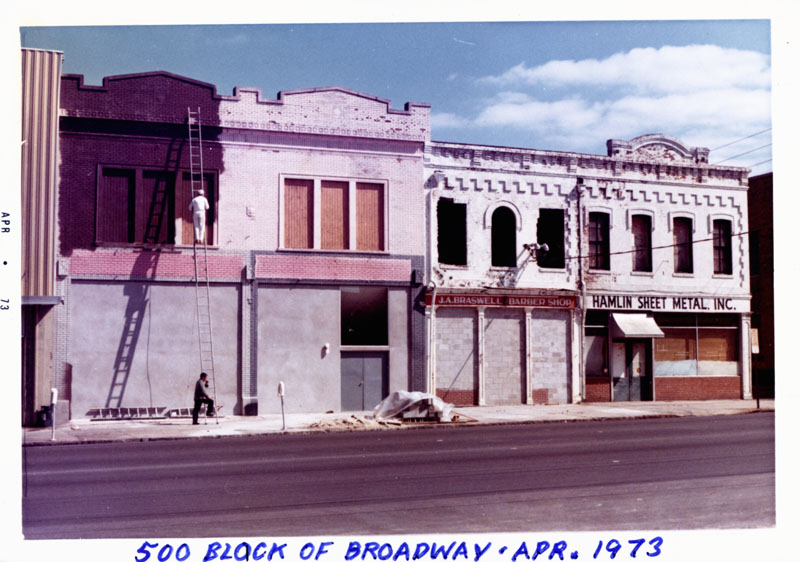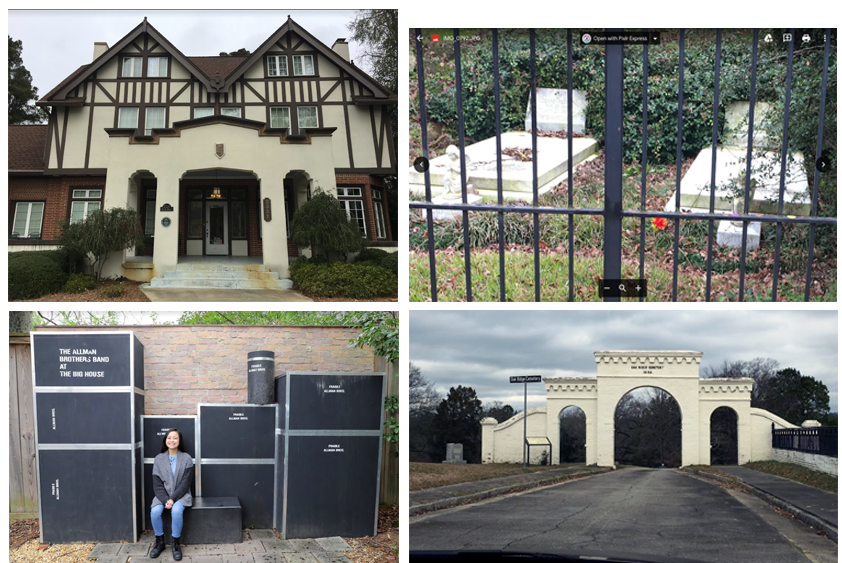 | |||
 | |||

|
THE ALLMAN BROTHERS BAND AT FILLMORE EAST (1971/ Capricorn Records, a division of Atlantic Recording Corp., NY) Cover photo by Jim Marshall. The Allman Brothers at Fillmore East, is one of rock's greatest albums, a two-disc live album of hard-rockin' southern rock, blues, and jazz, recorded at the legendary Fillmore East in the East Village of New York City over 2 nights in March 1971 (March 12 - March 13) . 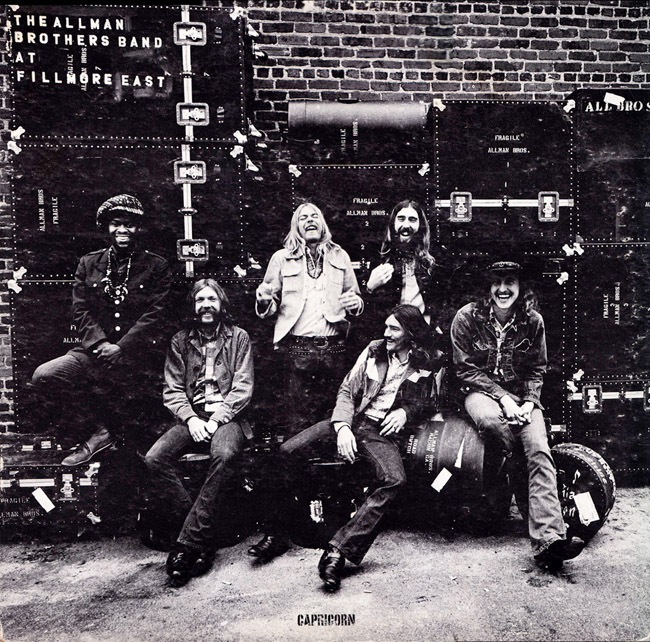
The double-album features such classic jams as "Whipping Post" (23 minutes long) and "In Memory of Elizabeth Reed" (13 minutes long)." The album cover features photographs of the band on the front and the band's roadies on the back. They were taken by the celebrated rock photographer James Marshall in Macon, Georgia, the home of Capricorn records and home base of the Allmans, supposedly after photos taken at the Fillmore in New York weren't deemed of high enough caliber for what was to turn out to be the Allman's career breakout album. Here's the front cover of the album, with left-to-right: 
(Photo by Jim Marshall) And now, the back cover of the album, featuring the roadies. The album list them like this: "Personnel on the back cover reading left to right: The Red Dog, Kim Payne, Joe Dan Petty, Mike Callahan, Willie Perkins & Twiggs on the wall." For all their hard work in stenciling the Allman Brothers Band name on the equipment boxes and hauling the boxes to the photo shoot, the roadies were given "PBR's" - Pabst Blue Ribbon beers. Three of the roadies are holding PBR cans in the shoot and another can is full-frontal by the drums; the effect being a large increase in PBR sales the year the album came out. 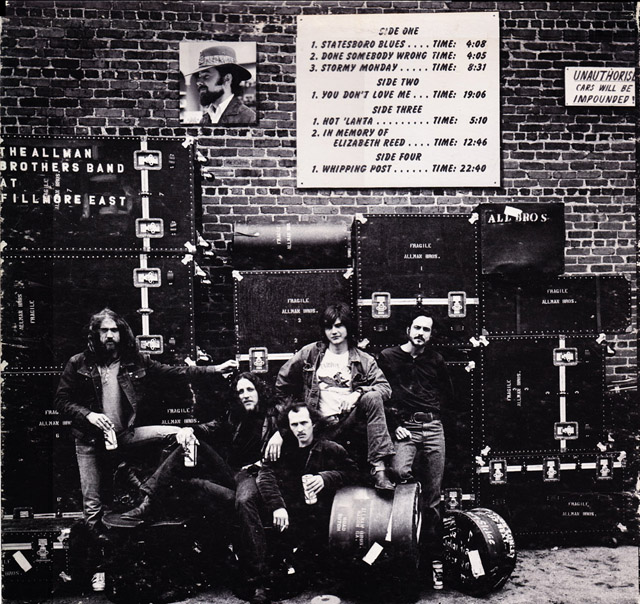
(Photo by Jim Marshall) The band in color - up-close... 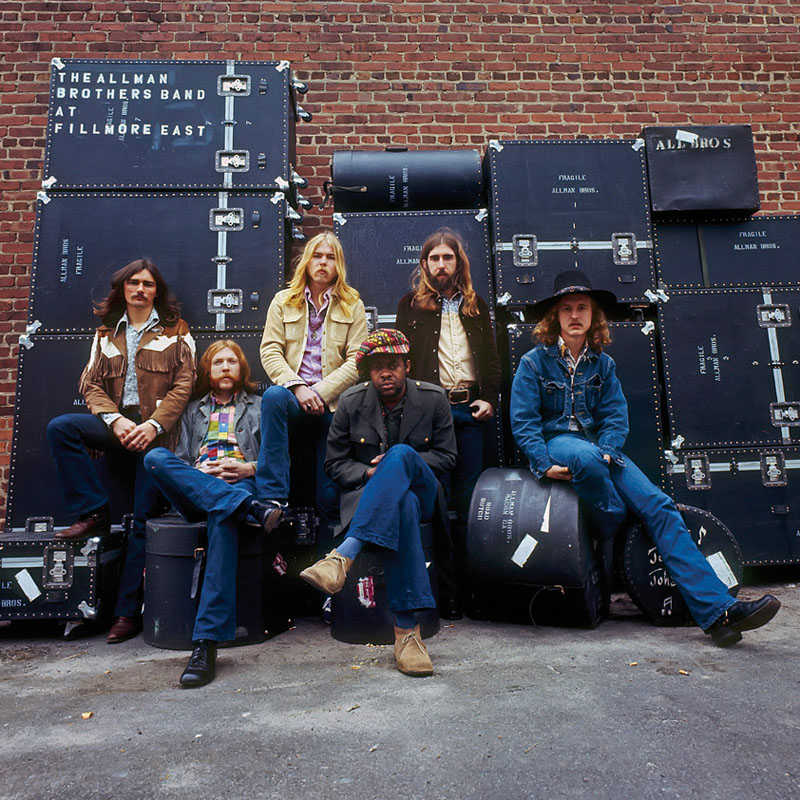
(Photo by Jim Marshall) ...and from further back.(note the U.K.-English spelling of "unauthorized," with an "s." Was that authorized?) 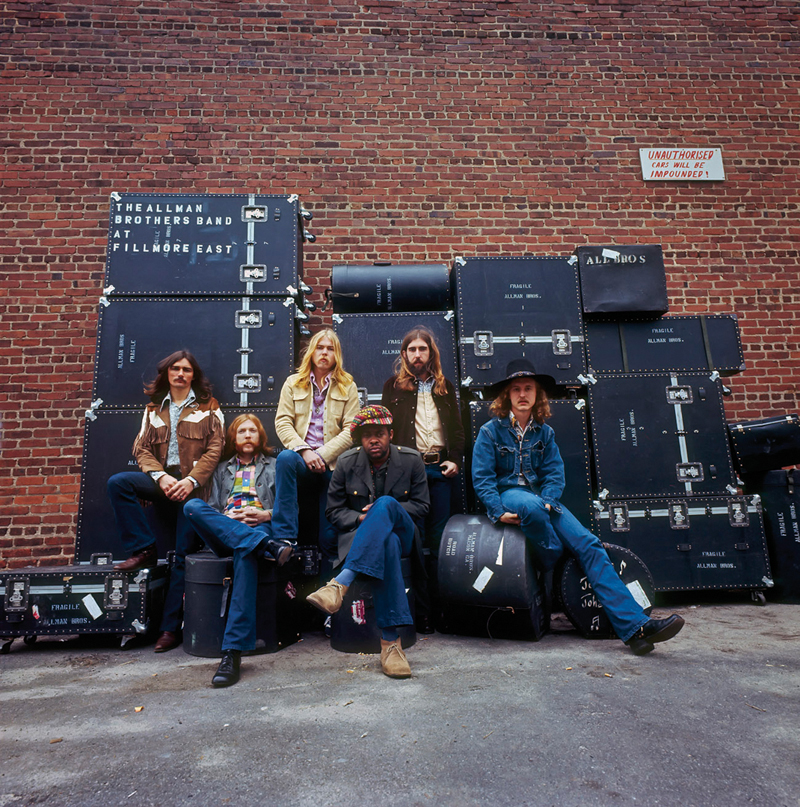
(Photo by Jim Marshall) There's a famous story that goes with the shooting of the Allman Brothers cover. According to Skydog: The Duane Allman Story by Randy Poe, the band was originally photographed for the album cover under the Fillmore East marquee. But no one liked he results. So famed New York cover photographer Jim Marshall was sent 900 miles south to Macon to photograph the band. At a roadie's suggestion, they decided to shoot it against a brick wall across from the studio. They also decided to shoot the roadies for the back cover at Duane's suggestion. (One of the longtime roadies, RED DOG, was not there that day so they put his picture up top afterwards.) According to Greg Allman's autobiography, Not My Cross to Bear, Marshall could not get the band to smile for the longest period of time. Also, it was a cold day and they were shivering. Toward the end of the session Marshall told them "Just one more roll..." and went about putting another negative roll into his camera. Just at that moment, who should Duane see walking down the street, but his drug dealer. Quickly Duane got up, made his purchase, ran back, and hid what he had bought behind his hands in his lap. The "naughty schoolboy" nature of the transaction, which Jim Marshall didn't see, got the rest of the band feeling giddy, and they all stated laughing Ñ which is precisely when Marshall got his long-awaited shot. Here's the front cover again, so you can see the magic moment when they all laughed at what Duane (2nd from left) was hiding behind his hands. 
(Photo by Jim Marshall) And here are roadies, along with the photographer, Jim Marshall, with arms crossed at right. 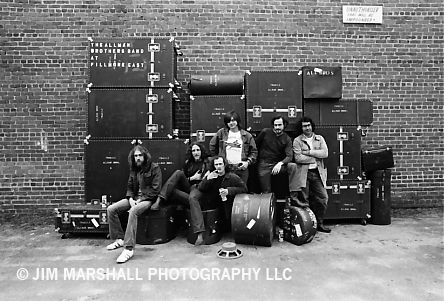
(Photo by Jim Marshall) Note: to see another selection of Jim Marshall's famous rock photography, after reading the entry, check out PopSpot #41 entitled "Bob Dylan and Friends, Greenwich Village, 1963." The color version of the Jim Marshall photo was used for Chronicles, the two-CD set that combined At the Fillmore with some live songs recorded at the same time from Eat a Peach. 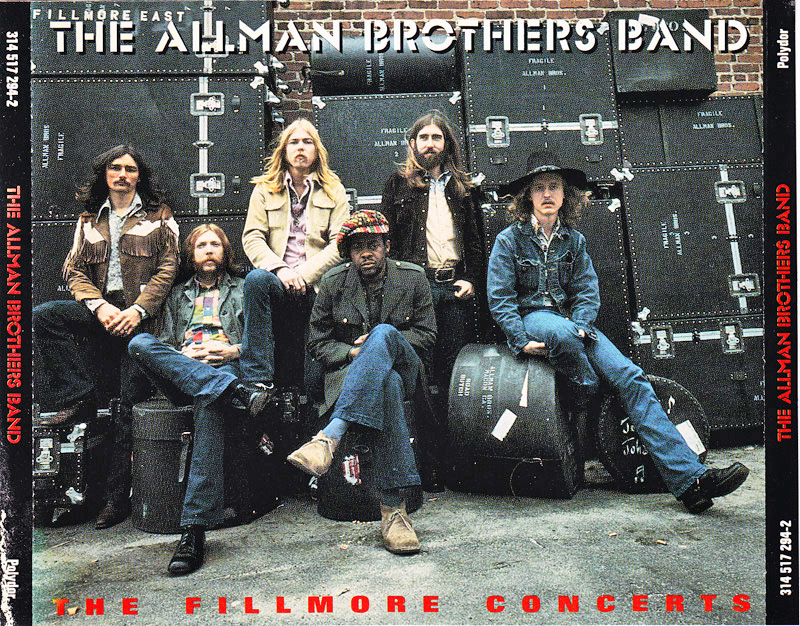
(Photo by Jim Marshall) Here's the back and sides of that set. (I believe that this photo was taken at the Fillmore West by Jim Marshall). 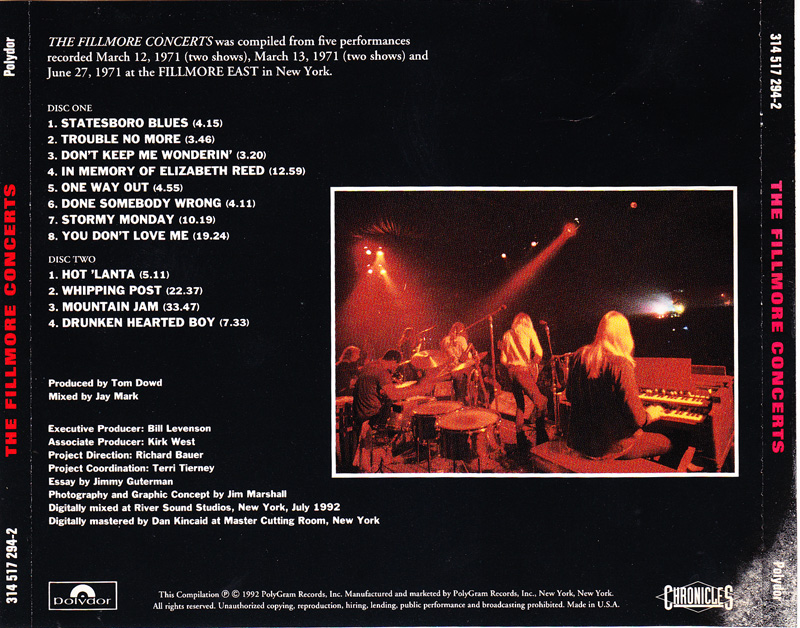
(Photo by Jim Marshall) This is a photo of the Allman Brothers Band playing the Fillmore East (patched together from a pan in a video; you can click to enlarge it). They were one of owner Bill Graham's favorite bands and he had them play the last three nights' of the hall's closing concerts (June 25, 26, 27, 1971). The The Allman Brothers at Fillmore East: album was recorded March 12th and March 13th, 1971 earlier that year.) 
Here's another photo of the Allmans onstage at the Fillmore; this one from June 27, 1971 - the night the music hall closed. 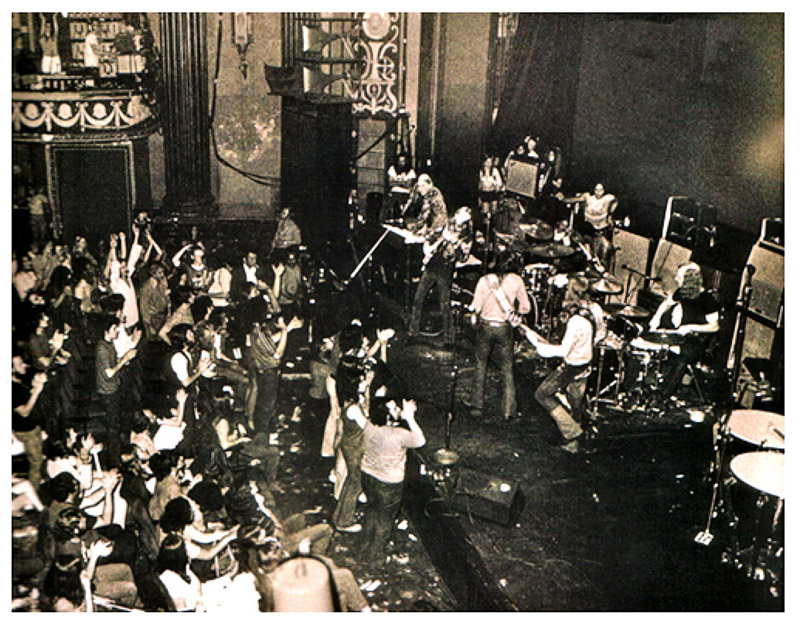
(photo possibly by Amalie R. Rothchild.) If you looked out at the marquee that night you would have seen this sign: The Allman Brothers Band on a triple bill with with The J. Geils Band, and Albert King. 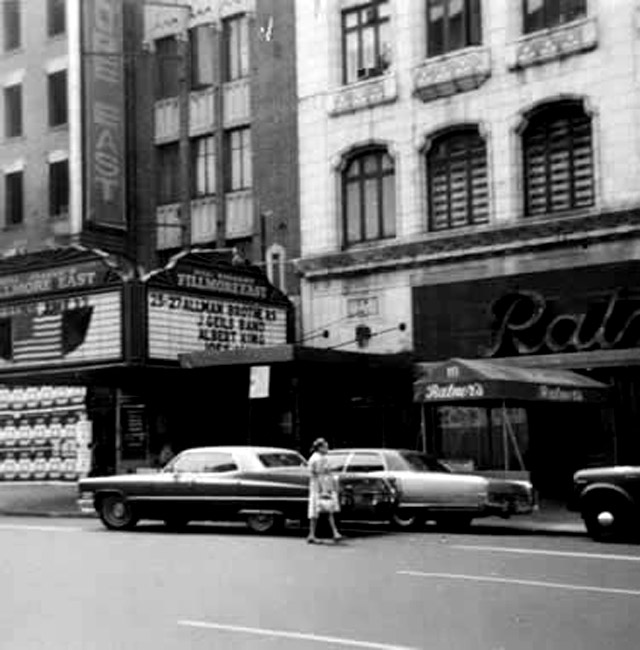
This is the front entrance to the Fillmore as seen today. It's now a bank entrance. There are photos from the old days along the corridor. 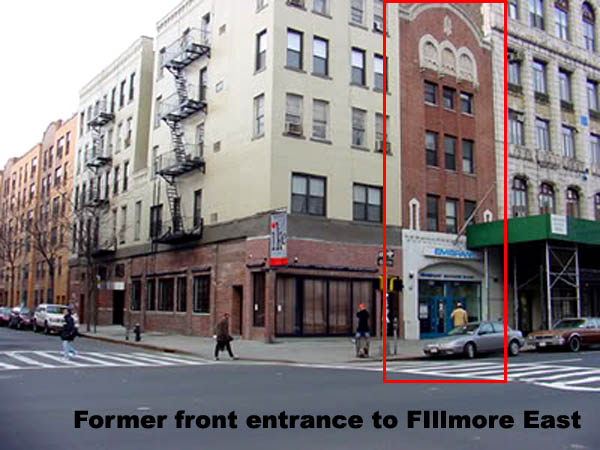
This diagram show the front entrance and the long entrance corridor one would have to walk down to get to the theater, which was actually ran along the middle of 6th Street. Most theaters in New York CIty are set up this way because the rent on an avenue costs a lot, but space along the area between avenues is a lot cheaper. (The photo has been stretched a little horizontally to match the map.) 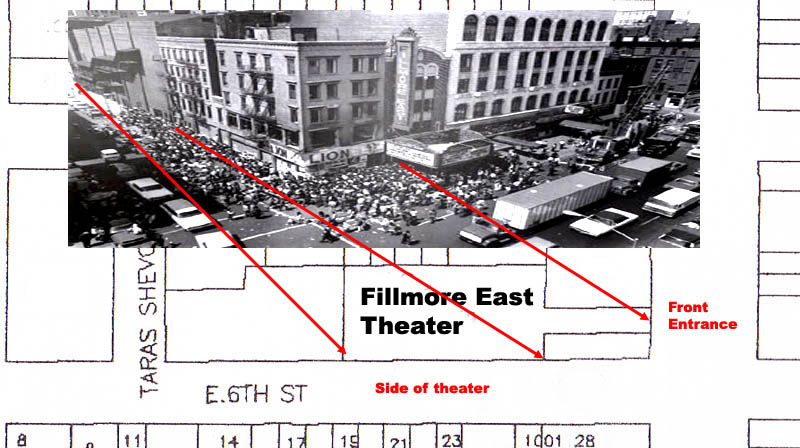
(photo by Amalie R. Rothchild) This shows the shape and large size of the Fillmore East (from an old map when it was the Commodore Theater). The auditorium ran along East 6th Street. The entrance corridor was on Second Avenue. 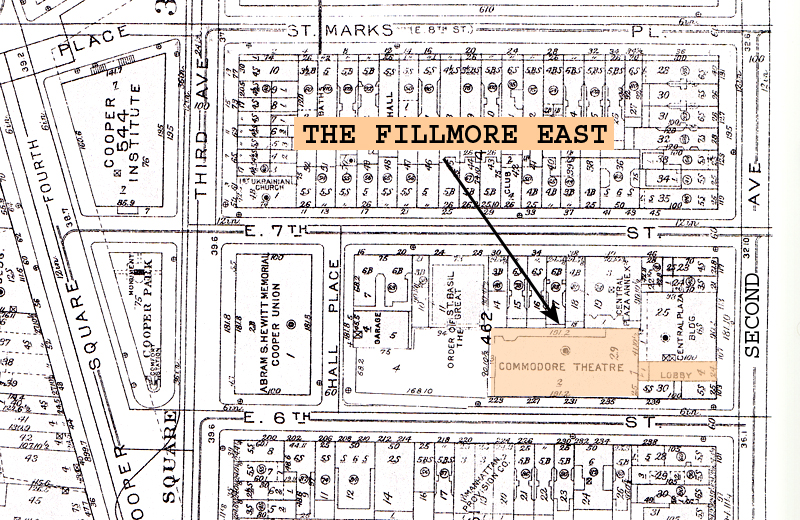
Many people assume the album cover was taken at the side of the theater (see far left in the red square), which was also brick, like the cover, but it was not. (It's all changed from what you see in the photo now that the theater has been converted into a residential condominium). The cover photo was actually taken, as we shall see, in Macon, Georgia, months after the concert they recorded at the Fillmore in New York. 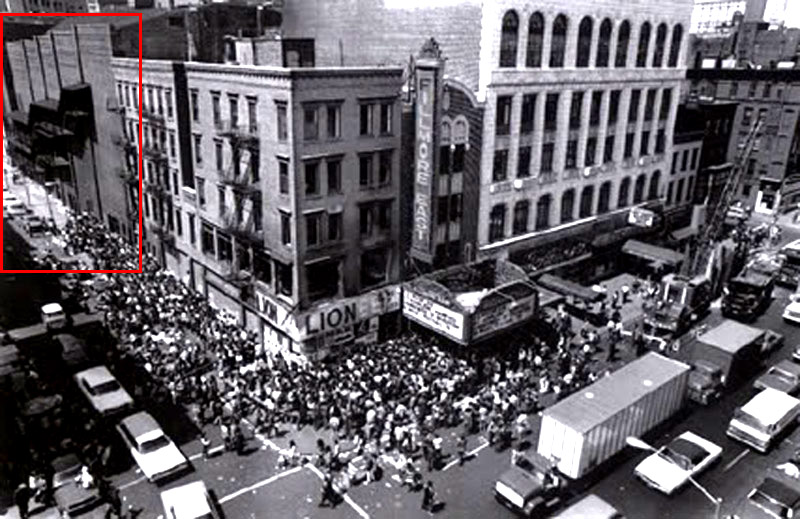
(photo by Amalie R. Rothchild) So let's boogie on down to Macon, Georgia and check things out. Here's where Macon, Georgia, is on a map in relation to New York CIty, where the Fillmore East was. 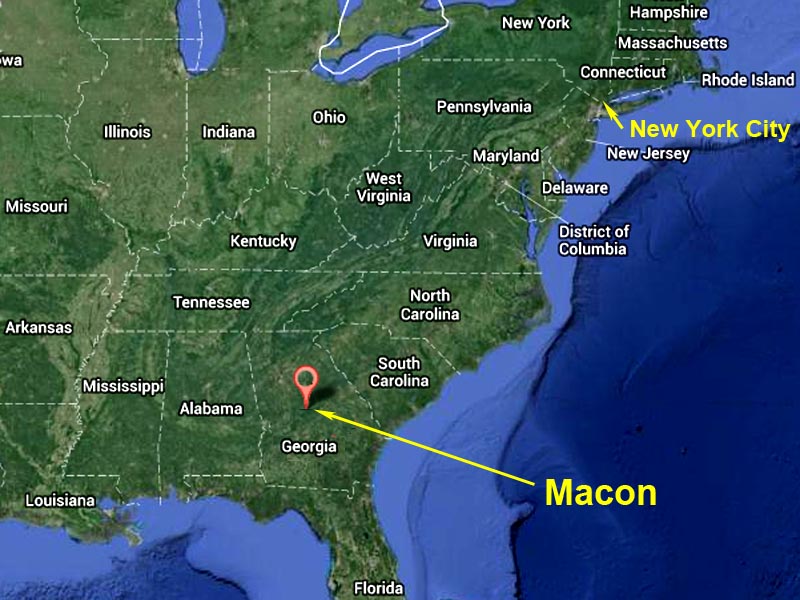
Here's a postcard of old Macon from back in the day when cotton was king. 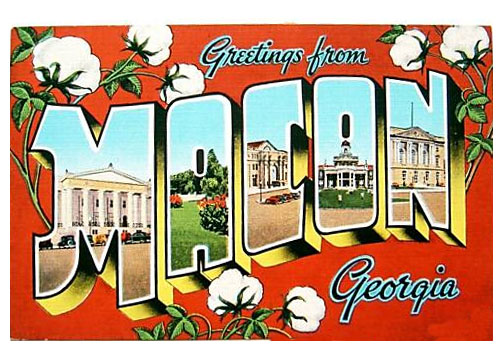
When the harvest came in, the streets were filled with bales of cotton. The Capricorn Records studio was at the end of this street, then a few streets to the right. In the back right, you can see a brick building with the same color bricks as were behind the band on the album (seen in black and white on the album, but we will soon see the bricks in color). 
Here's an overhead shot of the southern part of town, during the town's big growth years in the 1940's. The Capricorn Studios would take over one of these buildings just south of the bottom of the screen. 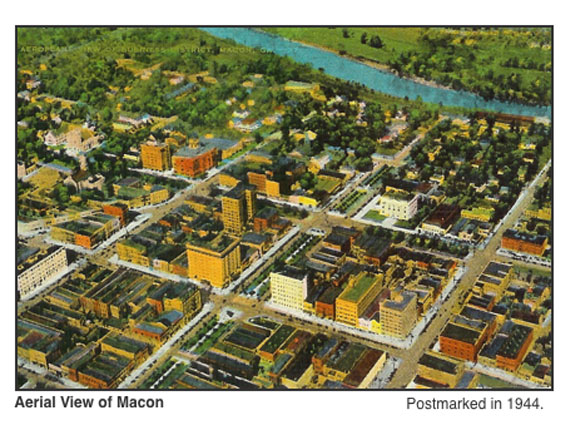
This is a shot of the Capricorn Studio complex from above. That used to be one solid block of buildings. Most have been torn down. They are slowly being replaced by modern buildings. For example, a large TV station resides just down the block and across the street from the old Capricorn Studios. 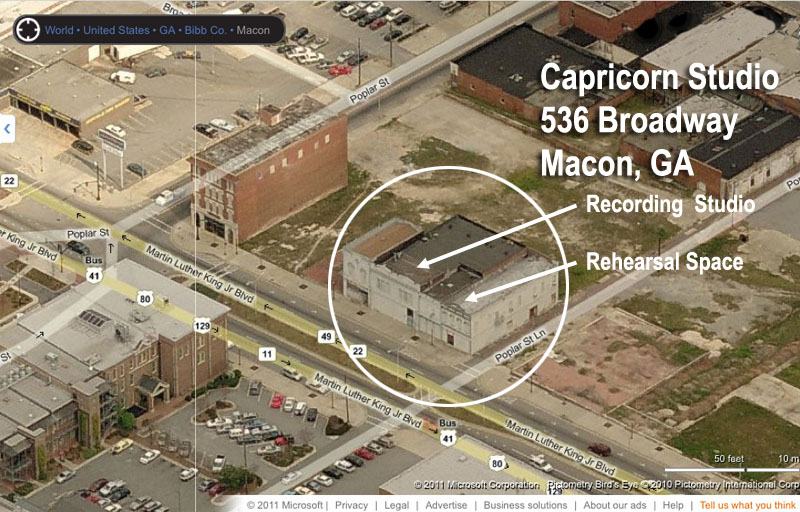
Here's a shot of the Capricorn Studios from the ground. According to a short video on YouTube made by Alan Walden, the brother of Phil Walden, Capricorn's owner, Capricorn originally bought the two little buildings on the right as the studio, but when Tom Dowd, their producer-to-be, visited them, he proclaimed those buildings to too short for a good recording studio; so Capricorn then bought the taller building next door - the one with the light blue entrance door -- and they built the studio in that building, using the 2 smaller buildings on the right as a practice space. (I'm not sure if Capricorn owns the small building at far left.) In addition, as I gather from other sources, in 1968 when they started to build the studio, it was originally named The Otis Redding Memorial Studio. It was changed the next year to Capricorn Studios. Among Capricorn's other acts that used the facility: The Marshall Tucker Band, The James Montgomery Band, Elvin Bishop, and Wet Willie. (for a full list, see Wikipedia). 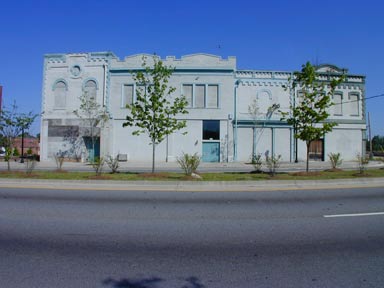
(photo from www.duaneallman.info/macon.htm (an informative website if you're planning a visit to see Allman Brothers-related sites in Macon.) Here's a closer view of the Capricorn buildings in a photo taken in 1974. (take note that the building to the left of the studio has a vertical-lined false front. More on this later.) All photos labelled in blue handwritten pen come from the Middle Georgia Archives at the Washington Memorial Library, Macon GA.
(photo courtesy of the Middle Georgia Archives) If you stood in front of the studio and looked down, what was in 1971, Broadway (now called Martin Luther King Jr. Drive), this was the view. (photo via Google Street View) When I originally looked to see where they might have taken the cover photo, I was looking for the brick pattern on the album on the right. Because of the broad horizontal line about 10 feet up that you can see on the on the Capricorn building, I figured it likely wasn't against that building. 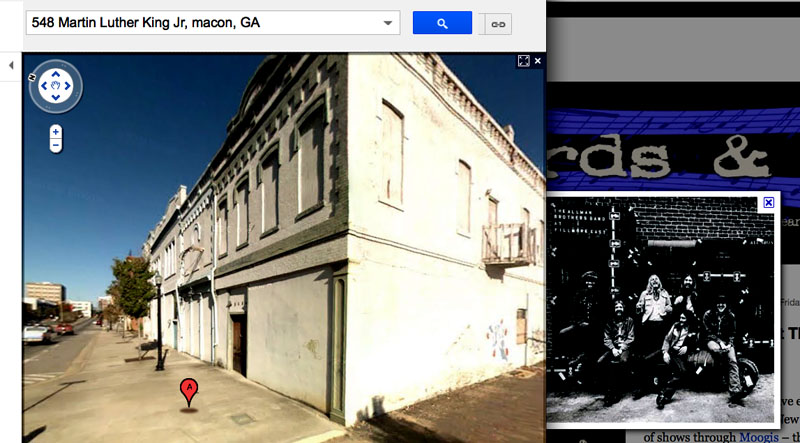
In his book, "Not My Cross to Bear" Greg Allman wrote that "you could see where the picture (i.e. album cover) was taken if you looked across the street from the front of Capricorn Studios." All that's left now is a parking lot (offscreen, left) and the building you see on the left. That didn't look like the right building from the brick pattern. 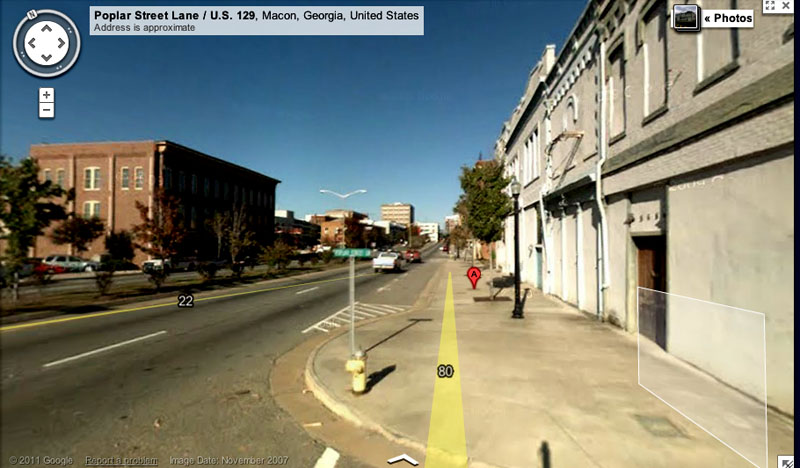
Here's another shot of Capricorn and another building on the same side of the street. In the old days it had a big sign reading "Jesus Cares," on top of it, so I'll call it the Jesus Cares building. 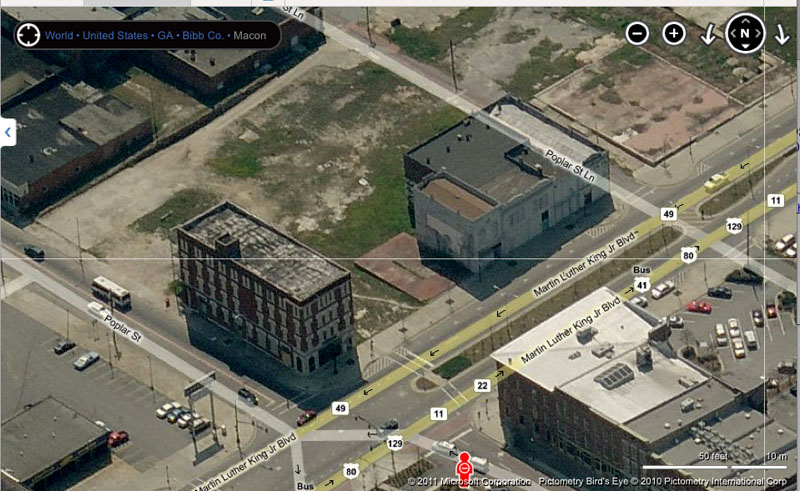
...and the same buildings from a different angle. There weren't many clues to go by, so I needed to know what buildings were around in 1971 when the band posed for the photo. 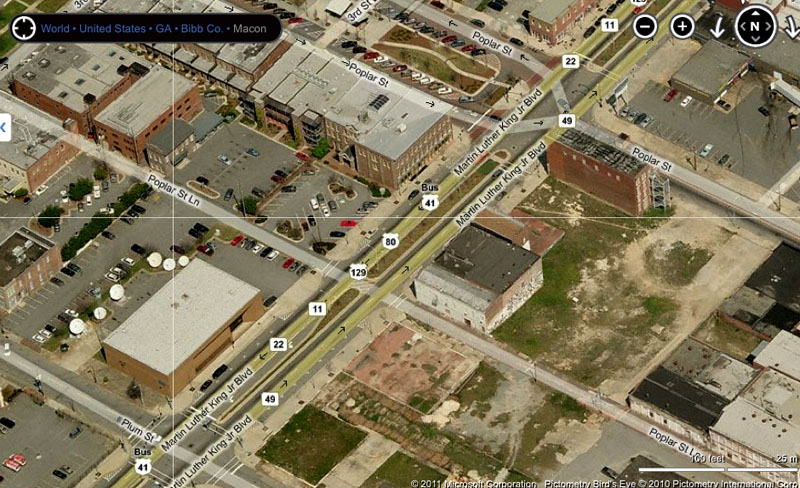
So I emailed the librarian, Muriel M. Jackson who is head of the Middle Georgia Archives at the Washington Memorial Library in Macon, and asked her if she had any overhead pictures of the area from around 1971, when the photo was taken. She didn't, but she did have an overhead shot from 1934, which she sent me. You can find it below. Before I go on, I want to thank Muriel, who immediately understood all my questions and was able to find everything I asked for. I have dealt with many librarians and archivists and she is tops. Thank you, Muriel. Here's the overhead photo of Broadway, from 1934. 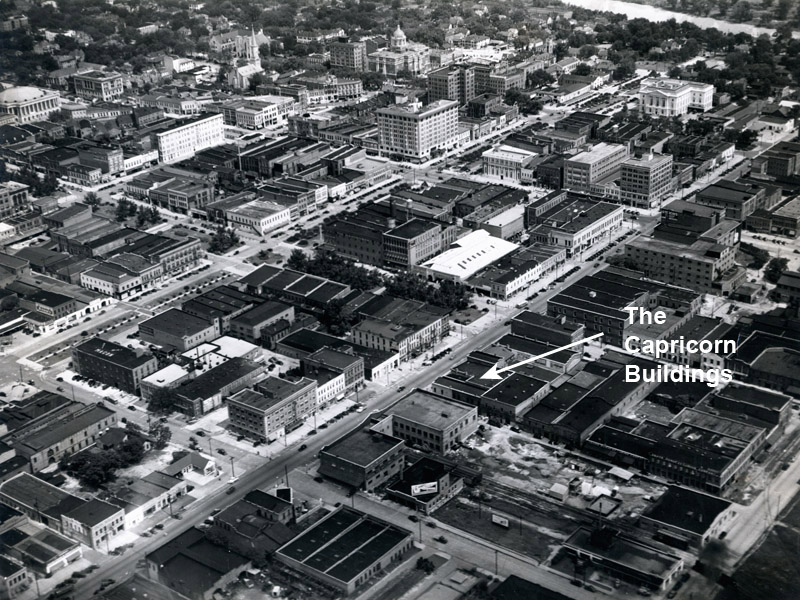
(photo courtesy of the Middle Georgia Archives) Here's a closer view. I have indicated in red the buildings which made up Capricorn Records. You can see that there is a unbroken wall of buildings on either side of the street from the alleyway, to Main Street. So where, we might ask, was there space for the Allman Brother's album shoot? We will soon find out. Remember, this photo was from 1934. 
(photo courtesy of the Middle Georgia Archives) Here's a side view of the Capricorn Records building from a website of a fan, along with his background on the album cover location. 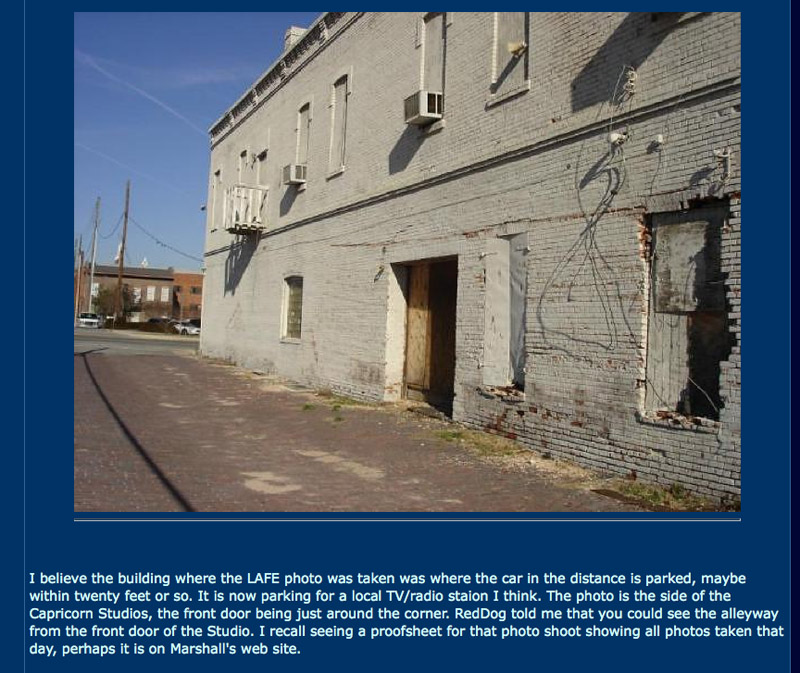
What sticks out to me, is his sentence: "Red Dog (i.e. who was a roadie) told me that you could see the alleyway from the front door of the studio (i.e. around the corner from this picture, on Broadway.) Thus, we have both Red Dog and Duane, in his autobiography, saying that one could see where the album cover photo was taken by looking across the street from the front of Capricorn Records. So let's see what was across the street in 1971, the year of the cover photo. Here, in a 1973 photo from the Macon Library, is a photo of the block across from Capricorn Records. To the left of the yellow garage is a small alleyway Poplar Street Lane). That alleyway is directly across the street from the southern wall of Capricorn. So Capricorn is directly across from the yellow building. 
(photo courtesy of the Middle Georgia Archives) This photo is the rest of the block across from Capricorn; the building to the right of the yellow, 3-door garage. Next to an empty lot, there is this building. It's all one building and it's called the Mercantile Building. 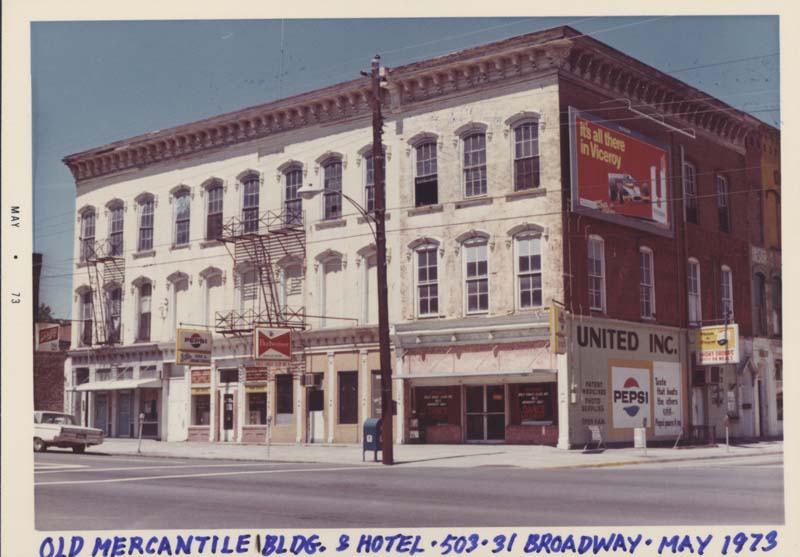
(photo courtesy of the Middle Georgia Archives) In this photo, I've put the two photos next to each other and the alleyway becomes more pronounced. 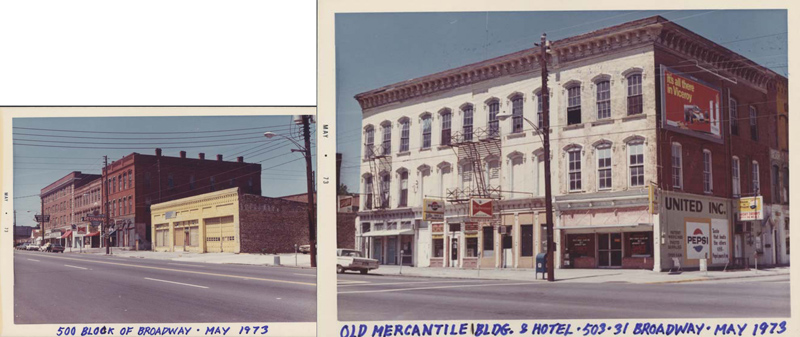
(photos courtesy of the Middle Georgia Archives) So, using Photoshop, I merged the two pictures together so we can get a better look at the alley. The question now is: How wide was that alley and could the photo have been taken there? Let's see. (YOU CAN CLICK ON THE PHOTO TO SEE IT LARGER) 
(photos (combined) courtesy of the Middle Georgia Archives) Here's a picture of the exact corner as the picture above taken during a Macon parade. Now, next to the Mercantile building (the darker building on the corner) we can see a white building with 7 windows running across it and a roof with a small half-round decoration in the middle. 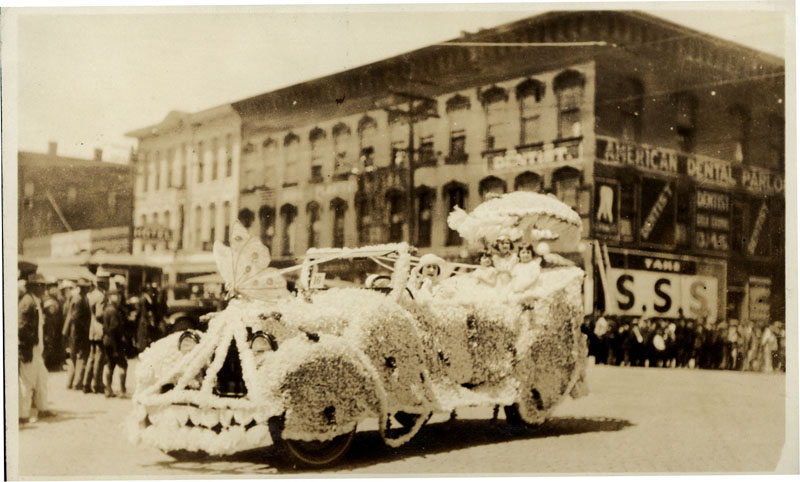
(photo courtesy of the Middle Georgia Archives) That turns out to have been a hotel. Here's a photo of it burning down. If the windows are about 2+1/2 feet wide and the space between the windows about 2 feet wide, I'd figure the building was about 30 feet wide. 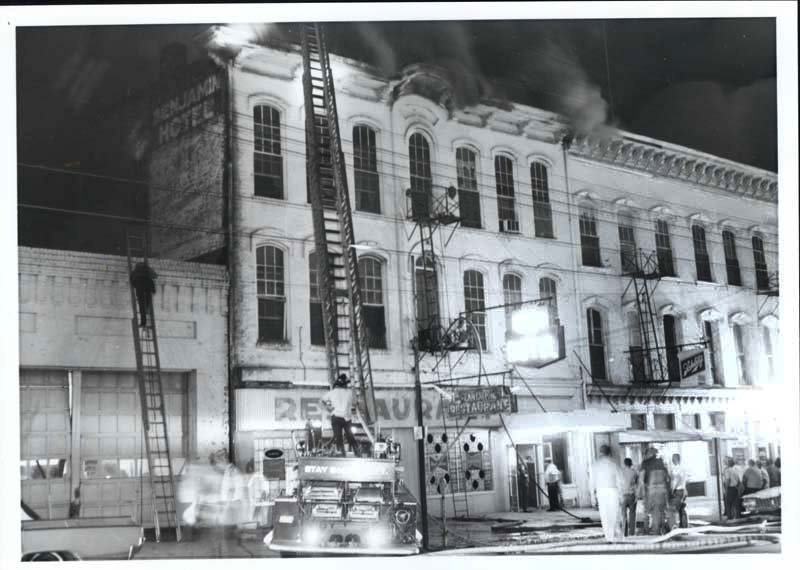
(photo courtesy of the Middle Georgia Archives) So here is what the alleyway, which I am judging to be about 30 feet wide, might have looked like (through Photoshopping a picture from New York City circa 1956) 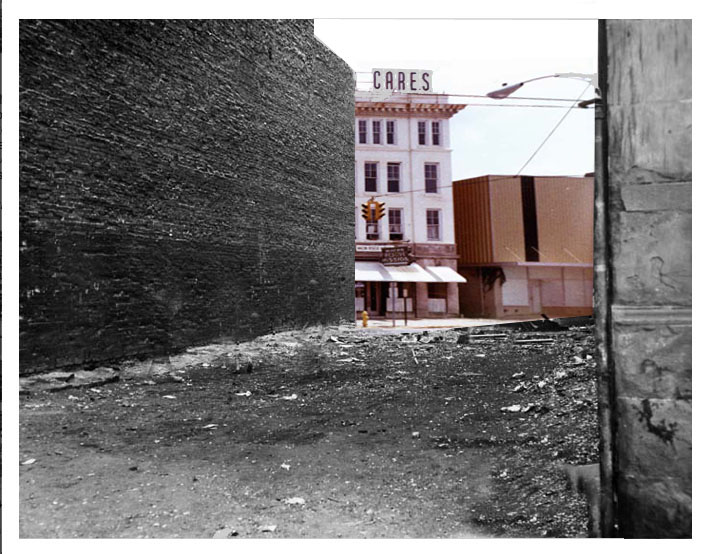
And here is how it might have looked while the Allman Brothers Band was having their album cover picture taken there in 1971. This is where I think it took place, based on all the evidence, though they could have been facing the other direction. 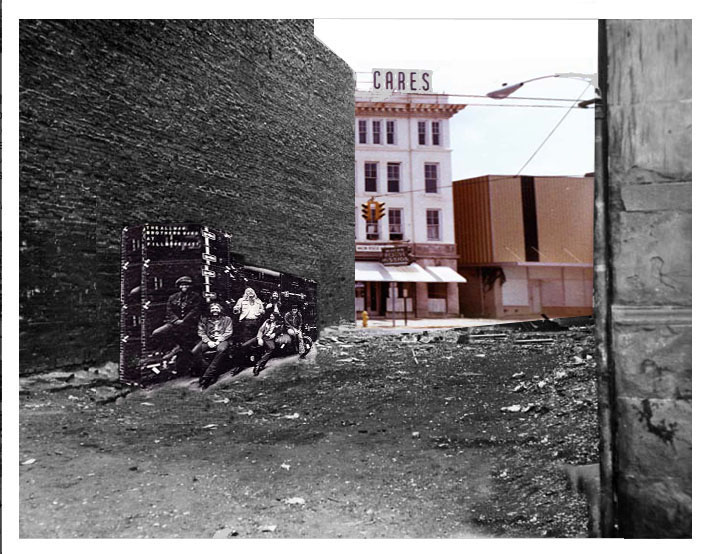
Or, if they were facing the other direction, it might have looked like this. 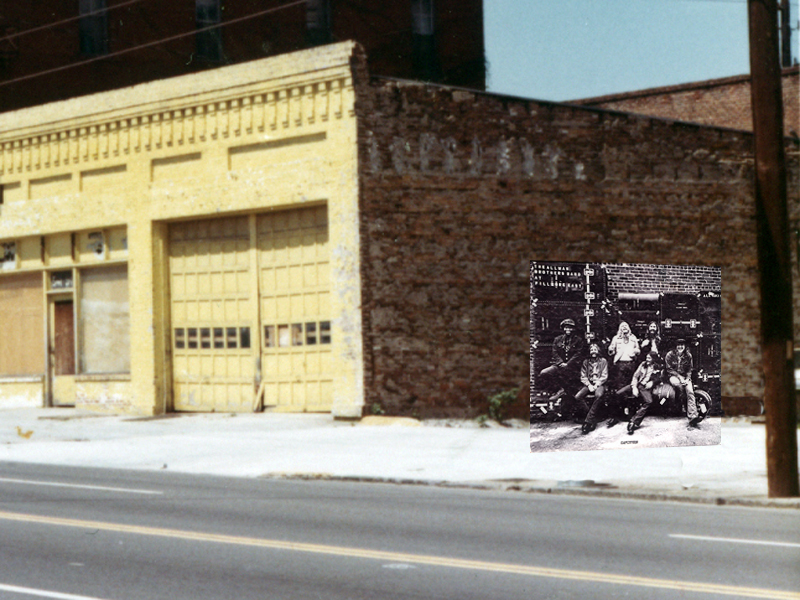
(background photo courtesy of the Middle Georgia Archives) So let's take a look at this from another angle. In this photo, I added the 3-door garage next to the alleyway on the left. 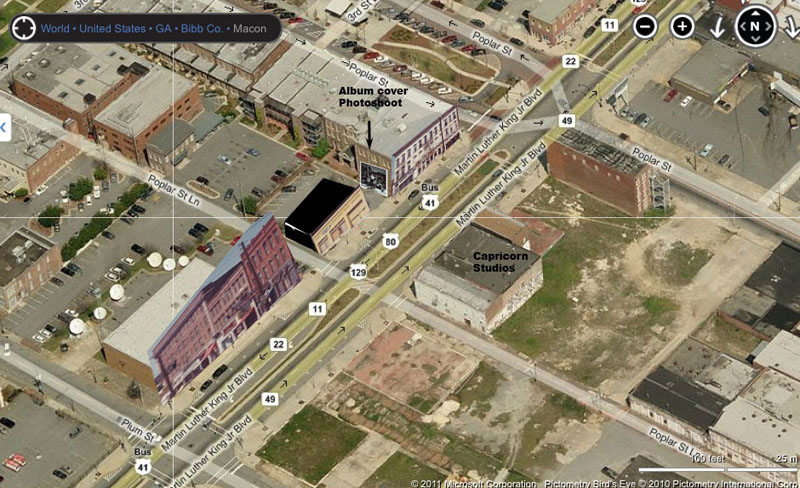
Here's another way to look at it, using the over head shot from 1934. 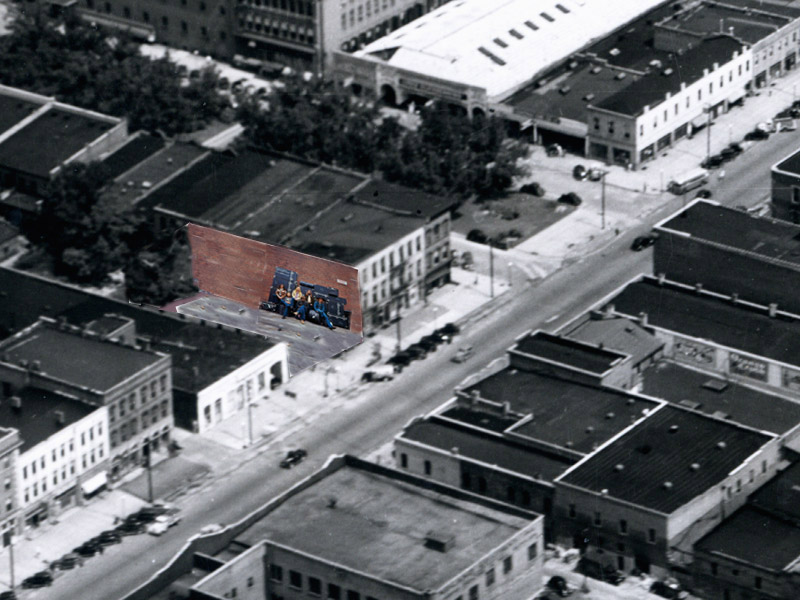
(background photo courtesy of the Middle Georgia Archives) Now if we go to Google street View to Google Earth and type in "Poplar Street and Broadway, Macon, Georgia", we will come to this. On the right is Capricorn Studios, on the left is the wall against which the band was photographed. As you can see, when they renovated that building, they changed the look of the brick to a different style and added four vertical "ribs," not to mention windows, going up the side. 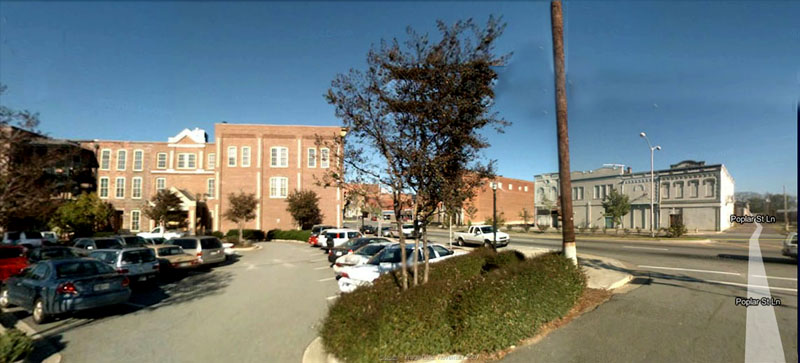
Here's the Mercantile Building Wall in close up, via Google Street Views. 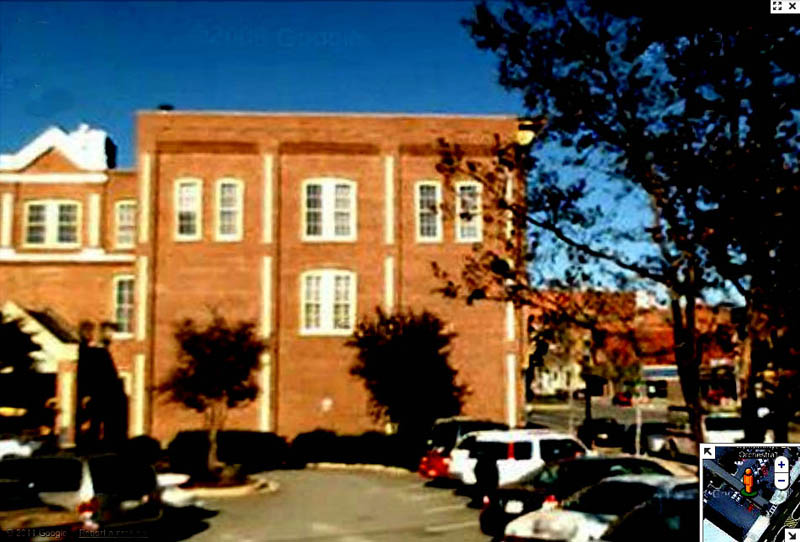
And here's the Mercantile Building Wall with the album PopSpotted in front of it. 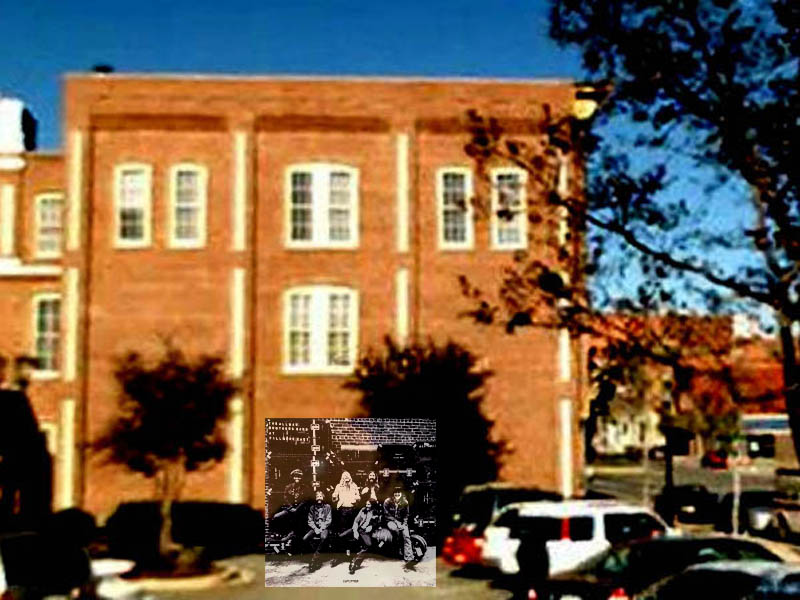
Now, there might are some people who say, "Well that sound's right, but are you sure the band was not photographed against the side of the building named "Jesus Cares" - the one on the street corner (see photo below). This spot has been mentioned on the Internet. The brick work in that building matches that of the album cover and there's a wide space in front of it for the band. I agree that the brickwork matches there. And if I was going to take a picture to try to match the original cover, I would take it in at the side of that building. However....back in 1971, that entire side of the block was filled with buildings (as we will soon see) so there was no way that band photo could have been taken there. Let me show you what buildings were on that side of the street back in 1971, again using photos from the library. 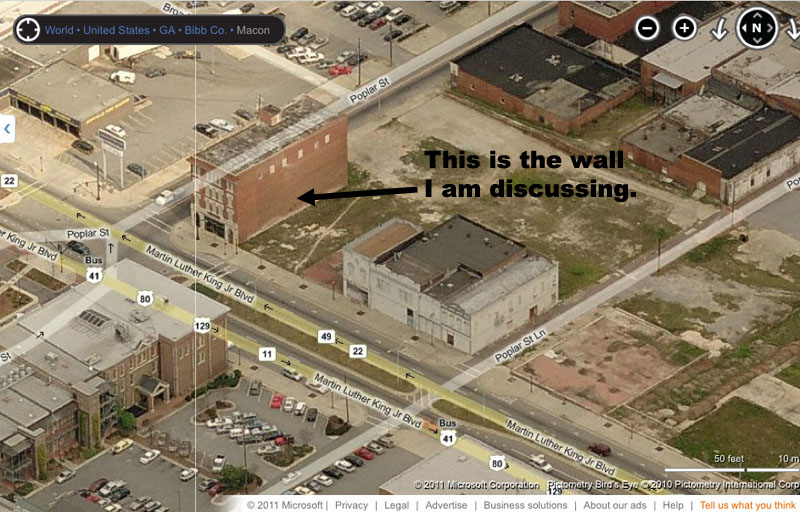
The "Capricorn" side of the street is a solid row of buildings, in this overhead shot from 1934. 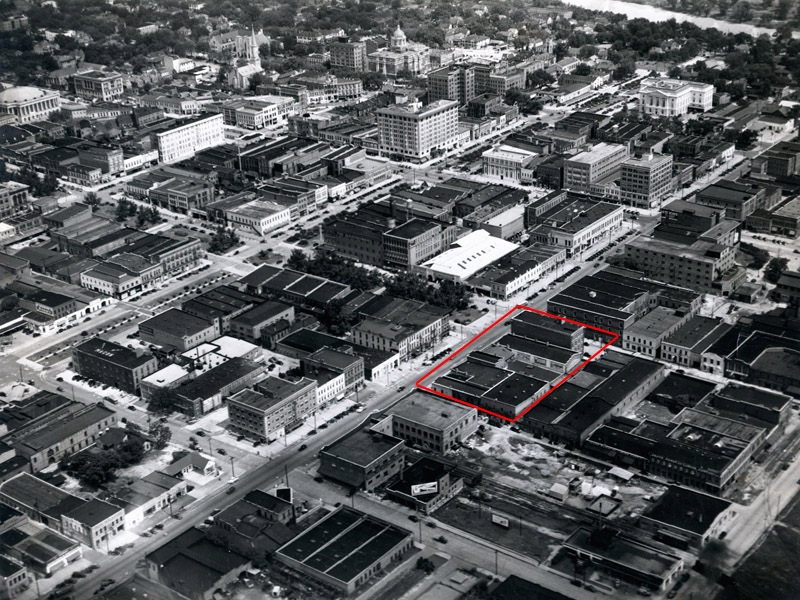
(photo courtesy of the Middle Georgia Archives) According to old photos, it still was in 1971, when the photo was taken. This picture shows a building right next to The "Jesus Cares" building in 1971. 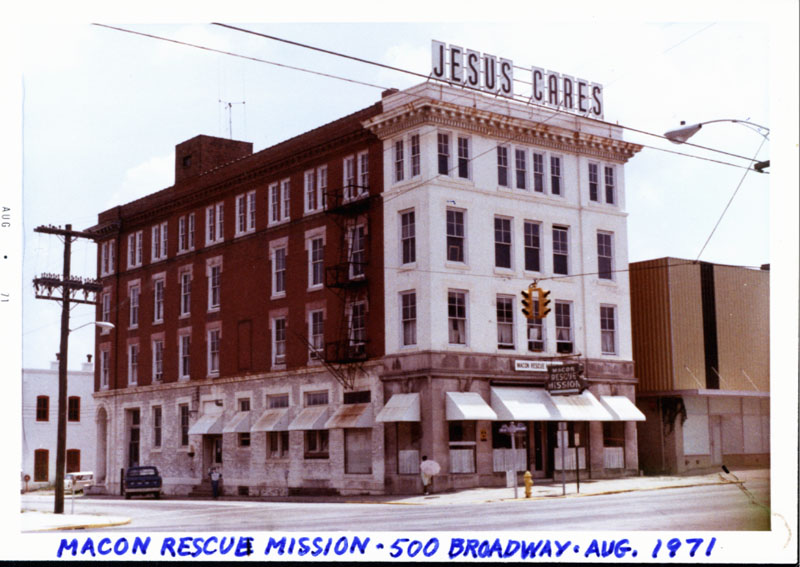
(photo courtesy of the Middle Georgia Archives) Here's my mock up of what what that side of the street looked like in 1971. On the left is the Jesus Cares building, which is still up. Then comes the bottling plant with the gold aluminum front tying several buildings together. then comes Capricorn records. (note the two story building next to the recording studio part of Capricorn Records, seems to have become part of the bottling plant. (CLICK TO ENLARGE, then back arrow to return) 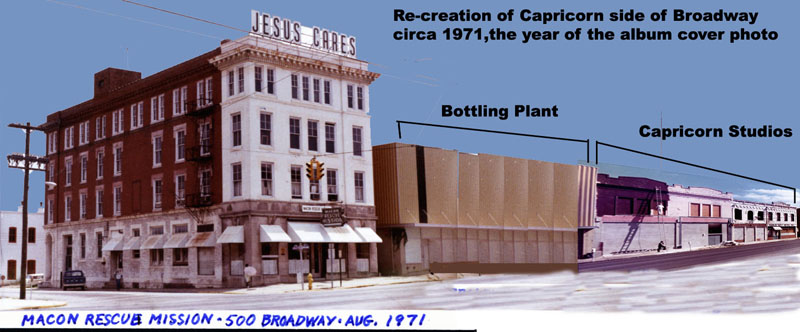
(pre-composite photo courtesy of the Middle Georgia Archives) Here's what underneath that aluminum front of the bottling plant - from a photo from 1971 - the year of the cover shot. 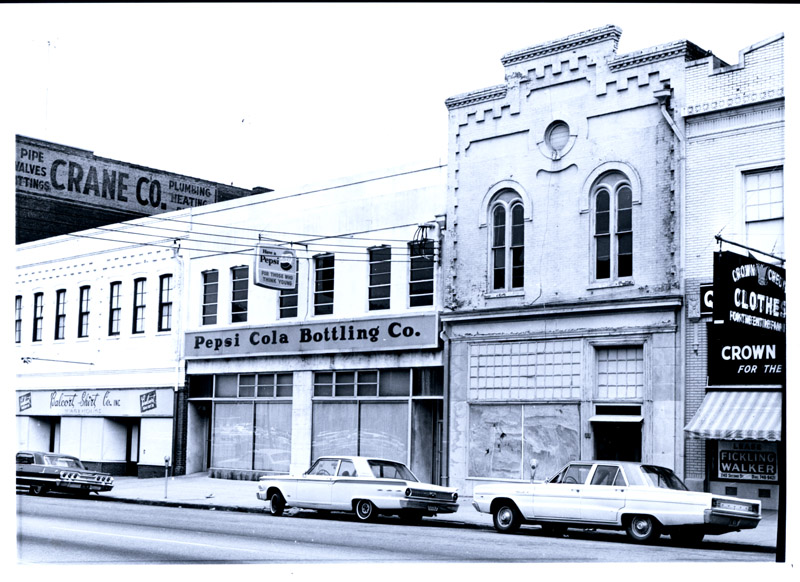
(photo courtesy of the Middle Georgia Archives) Now you may ask, how do I know the bottling plant was there. And for that we have to go to a photo taken in 1971 in the back of the bottling plant. That would be this photo below. It's the front of the bottling plant on Poplar Street, which runs parallel to the side of the "Jesus Cares" building. 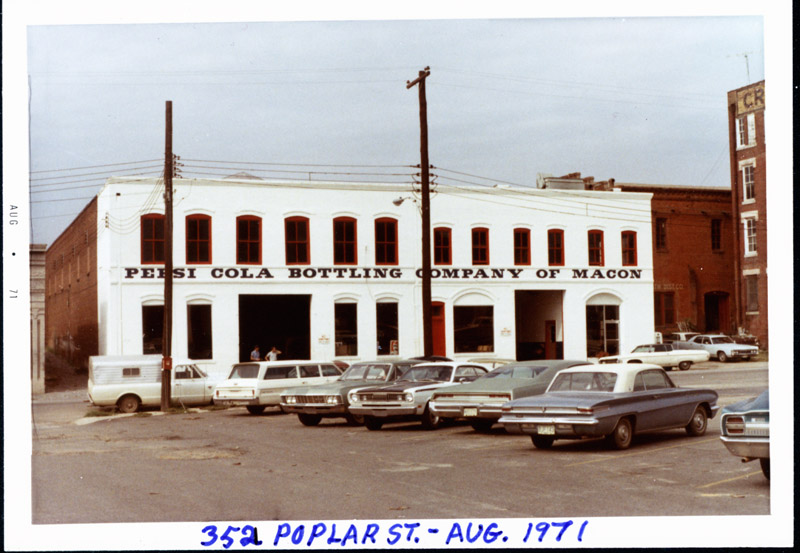
(photo courtesy of the Middle Georgia Archives) In this picture, I have drawn colored lines around 1) the Jesus Cares building (red); the bottling plant next to it (blue), and the bottling plant behind it (yellow). Together, they show there was no room to set up the photo next to the Jesus Saves building. In addition, we have Gregg Allman writing in Not My Cross to Bear that you could see the space "across the street" if you were standing in front of Capricorn Studios." And you wouldn't have been able to see this space from there, as it was "down the block." 
(photos courtesy of the Middle Georgia Archives) OK, so the circled wall is the wall I'm 99% sure took the photo in front of. Of course, they could have taken it in that area, but in the other direction, against the garage, but I don't think the bricks were high enough in that direction. 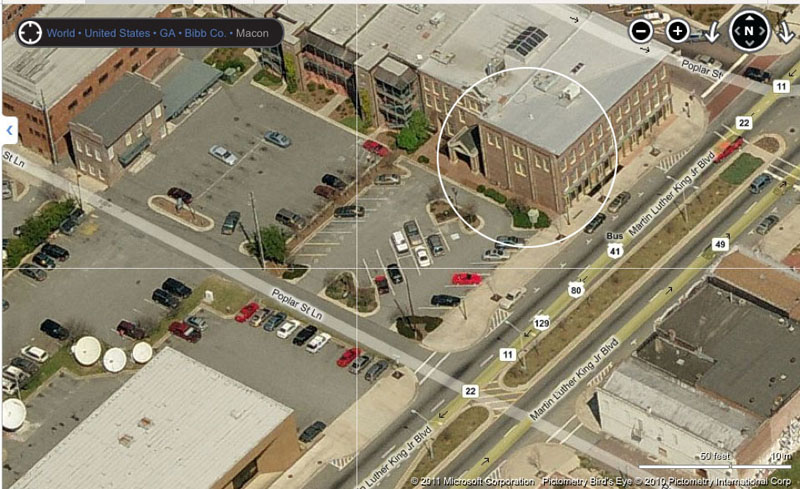
So if you go there today to photograph yourself against the wall, the wall will have four vertical support ribs in it. 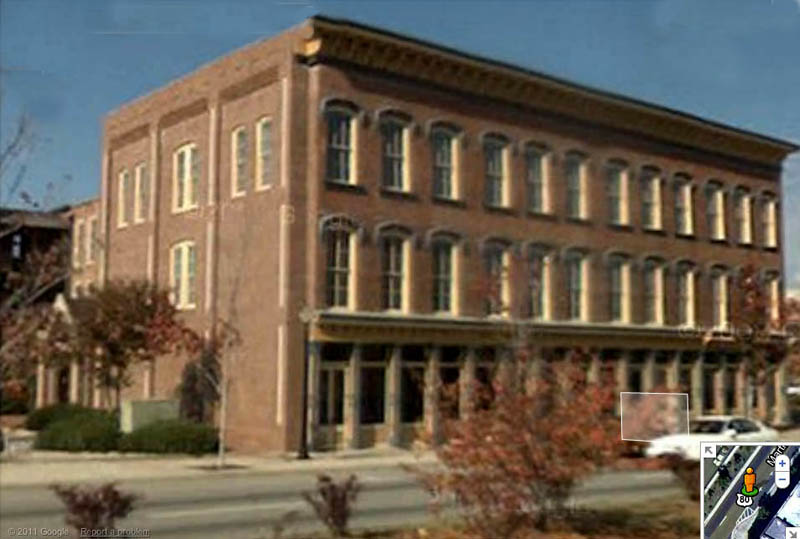
On the other hand if you want to get a photo that looks just like the Allman Brothers cover, you could go across the street and take a photo against the JESUS CARES building, which has the same brick pattern as the album cover did. 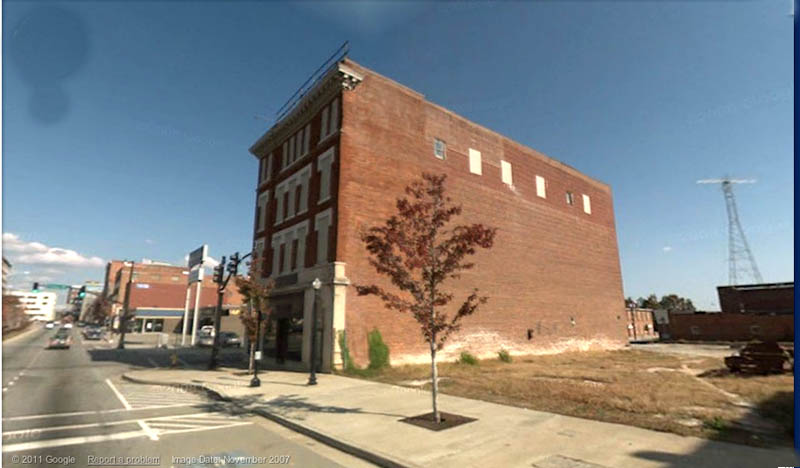
And in a closer view... 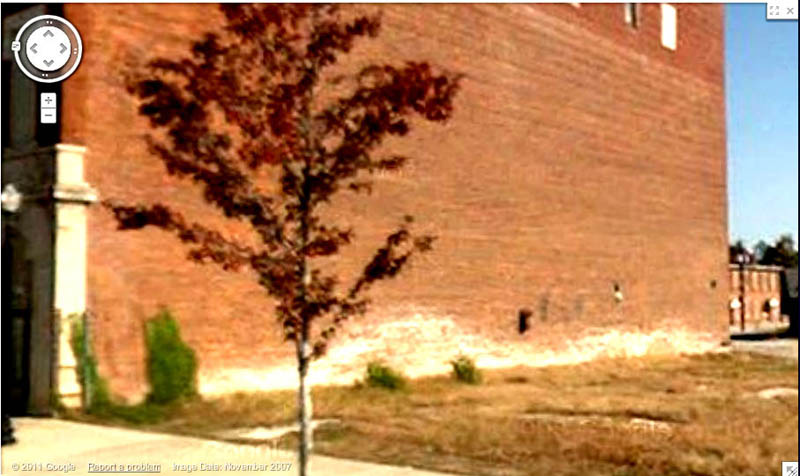
..and in an extreme closer view:
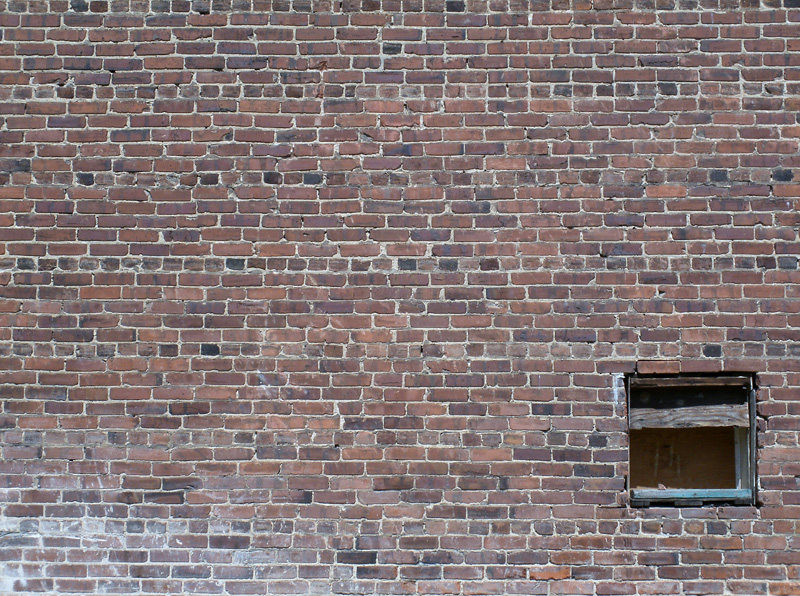
You can see how the brick pattern is the same as from the album. 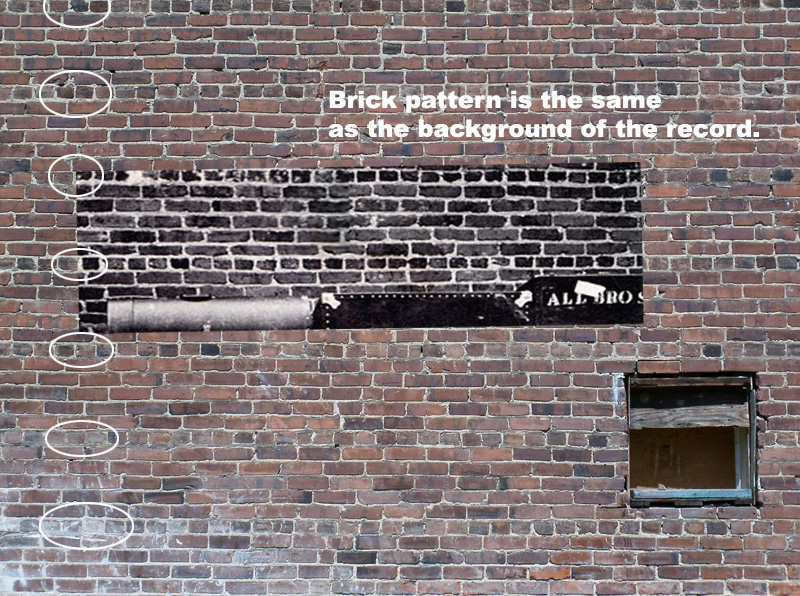
So here's what the album it would look like PopSpotted against the wall. Makes you want to eat a peach! 
...which brings up the 1972 follow-up album to LIVE AT THE FILLMORE EAST, the album - EAT A PEACH, which is also contained parts of live sets the Allmans did at the Fillmore in 1971, along with some newer songs, like "Blue Sky." The cover features a exaggerated-sized peach on a flatbed truck from a series of postcards done by the Curt Teich Co. since the 30's. According to Wikipedia, the album art director, W. David Powell at Wonder Graphics, found the front and back postcards at a store in Athens, Georgia. 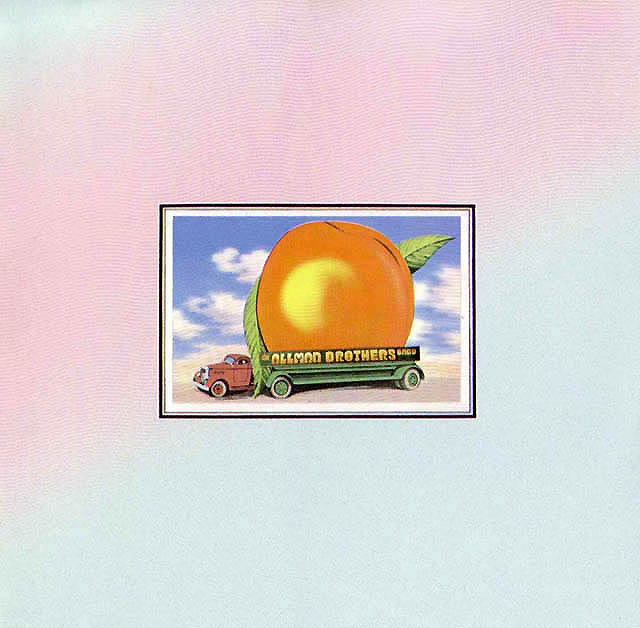
Here's the same postcard that I found on Ebay. 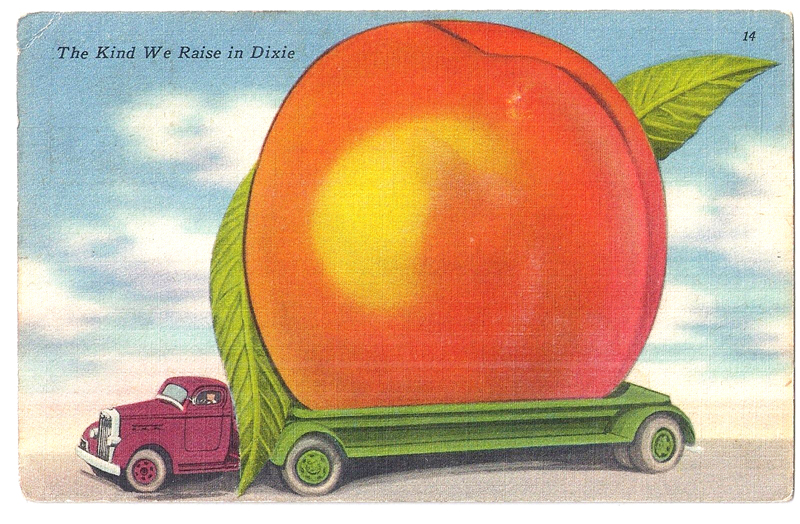
This view shows the front and back covers at the same time. 
Here's a close-up of the back cover. W. David Powell also designed the letters on the train car's side. 
This is the closest I could find from Ebay. The postcard company made "exaggerated" postcards for the products from all over the country. And some with the insects and animals. 
Perhaps if we cut open the watermelon on the front of Eat a Peach, we'd come across this southern beauty. Thanks for reading! 

ADDENDUM 1 In 2018, Alyssa Tumale, a New York City college student offered to send her photographs of a trip to Macon that she and her father took to see the Allman Brothers and Otis Redding sites. To see her 50 pictures, click here:
|
||

